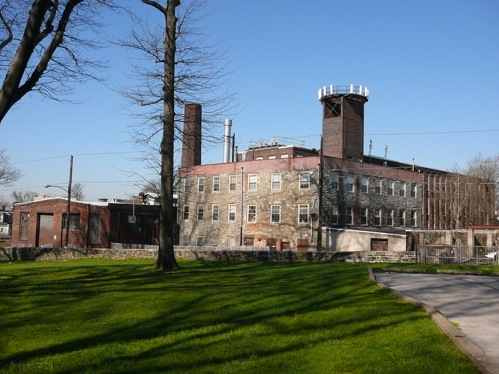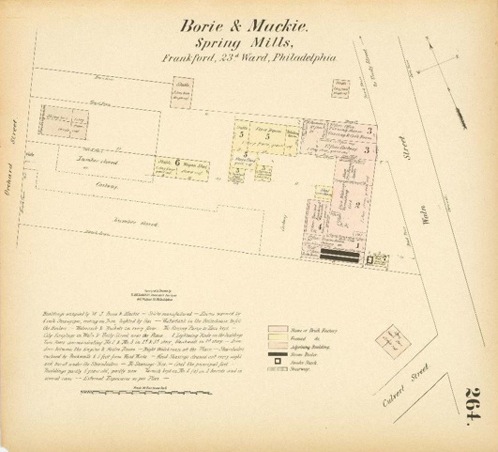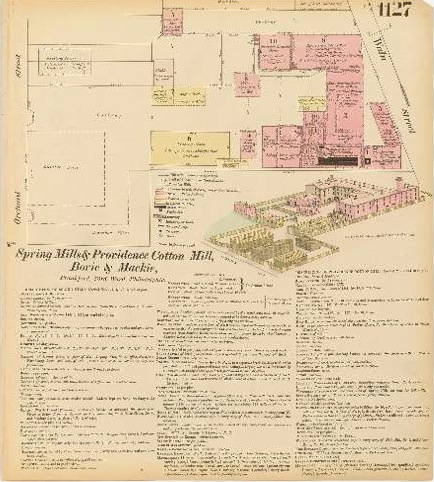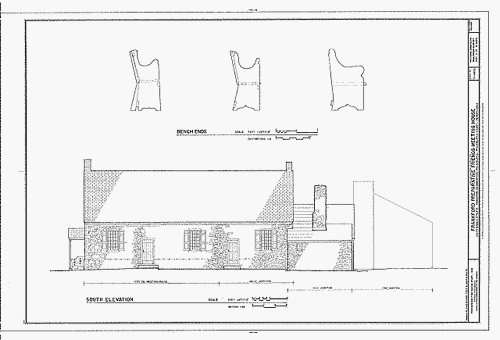
View from the Friends Meetinghouse to the east facade of the oldest part of Spring Mills along Waln Street (2007).
1768-1862 Friends schoolhouse (demolished)
1862- Spring Mills / Borie & Makie (umbrella & parasol sticks, cotton yarn)
1889- Montgomery Ford (umbrella sticks)
1894- David M. Hess (chemical works)
1895-1945 Wallace Wilson Hosiery Co. (infants hosiery)
c. 1920- Malcolm Mills (yarn)
1946-2004 H. Riehl & Son (textile machinery)
2004- Pappajohn Woodworking (custom woodworking) & misc tenants.
4355 Orchard Street, Philadelphia PA 19124
(east side between Church Street and Unity Street, property extends back to Waln Street; originally Waln Hill at Unity Street)
© Barbara M. Auwarter and
Joyce Halley, Workshop of the World (Oliver
Evans Press, 1990).

"Borie & Mackie, Spring Mills" (date?),
Hexamer #264.
On the grounds of a razed
1768 schoolhouse and adjoining the oldest Friends
Meetinghouse in Philadelphia, Borie & Mackie
constructed Spring Mills from 1862 to 1874.
1
The mill complex
spread from its original 1862 building on Waln Hill (now
Waln Street) through to Orchard Street, its present main
entrance. The steam powered mill manufactured umbrella
and parasol sticks, a major industry in Frankford since
Colonial times, and employed one hundred hands. The
by-product, wood shavings, were conveyed by wheelbarrow
to the steam boilers to power the plant. As a precaution
against the ever present danger of fire, the walls of the
shaving room were constructed of stone, the boiler room
constructed of brick, and a water cask and fire buckets
were kept filled at all times on every floor. By 1877,
Borie & Mackie had expanded Spring Mills to include
Providence Cotton Mill for the manufacture of cotton
yarn. 2
Twelve years
later Spring Mills was owned by Montg. Ford and continued
with the production of umbrella sticks.
3

"Spring Mills & Providence Cotton Mill,
Borie & Mackie" (1877), Hexamer
#1127.
Manufacturing at this site changed significantly by 1894
when David M. Hess had his chemical works there. The main
building on Orchard Street with a date of 1895 built into
the bricks of the front wall demonstrates the pride mill
owners took in their establishments. By 1910,
manufacturing reverted to textiles once again, the major
industry in Frankford at that time. 4
Wallace Wilson
manufactured infants' hosiery for at least two decades,
subsequently sharing the site with Malcolm Mills,
manufacturer of yard goods by 1920. 5
Riehl & Clark's, established in 1850 at Charlotte
Street in Philadelphia, re-established itself as Henry
Riehl & Son in 1885, and today occupies the entire
mill complex, manufacturing and servicing textile
machinery as it has since 1850 6
Textile machinery
using finely crafted maple wood shuttles and ancient loom
movements is now produced by Riehl's for textile
manufacturers, some of whom produce goods for the space
program. Complex Jacquard looms, used since Victorian
times, are operated by a technology similar to that of a
computer.
1 Guernsey A.
Hallowell, For
A Greater Frankford / Historical and Industrial
Celebration (Philadelphia, 1912), pp. 33
and 55; see also, "Borie & Mackie, Spring Mills" (1874),
Hexamer #792.
2 "Spring Mills & Providence Cotton Mill,
Borie & Mackie" (1877), Hexamer
#1127.
3 Ernest Hexamer &
Son, #287 (1889). [Editor's note: this footnote
appears as published in 1990 but seems incorrect].
4 Philadelphia City
Atlases for 1894 (23rd Ward, Plate 2) and 1910 (23rd
Ward, Plate 4); see also, (Name of author of The Old
Northeast)
5 Philadelphia City
Atlas, 1920, 23rd Ward, Plate 4, Philadelphia City Atlas,
1929, 23rd Ward, Plate 4
6 Henry Riehl & Sons,
archival material found by B. Auwarter and J. Halley on
site. The material consists of a
promotion/advertisement/flyer, a ledger sheet of the
company, and a wood shuttle. They were all donated to the
Historical Society of Frankford.
Update May
2007 (by
Torben Jenk):
The
date '1895' on the Orchard Street facade probably refers
to the founding date of the Wallace Wilson Hosiery Co.
Other similar markings were obscured after WWII by the
Wagners, the owners of H. Riehl & Sons. Paul Wagner
remembers the date '1907' which probably reflects the
date of construction and "Established... Wallace
Wilson..." H. Riehl went out of business in 2004. The
building complex was bought by Matt & Ian Pappajohn
who use 12,000 sf on the first floor for their custom
woodworking business and rent the other space to various
commercial enterprises and artists. Gregory August, an
interior decorator, is on the second floor and has
preserved a number of the Riehl patterns as display
pieces. A sculptor and artist are on the third floor. In
the older adjacent building are a coffee roaster, graphic
design firm and a residence.
The charming Quaker Meeting House (c. 1768) survives east
of Waln Street, surrounded by simple graves and a stone
platform which likely helped early Friends descend from
their carriages. It is now used as a community center.
East of the cemetery is the former home of Kingsbury Inc.
(now in northeast Philadelphia). In 1912, Dr. Albert
Kingsbury invented the tilting-pad "six shoe" thrust
bearing and ever since they have remained the
technological leader in babbitted fluid film thrust and
journal bearings for all types of rotating machinery.
This 40,000 sf building has also been successfully
adapted for multi-tenant use.
See also:

"Frankford
(Preparative) Friends Meeting House, Corner of Unity
& Walnut Streets, Philadelphia, Philadelphia
County, PA" - Historic American Buildings Survey
PA-6652.